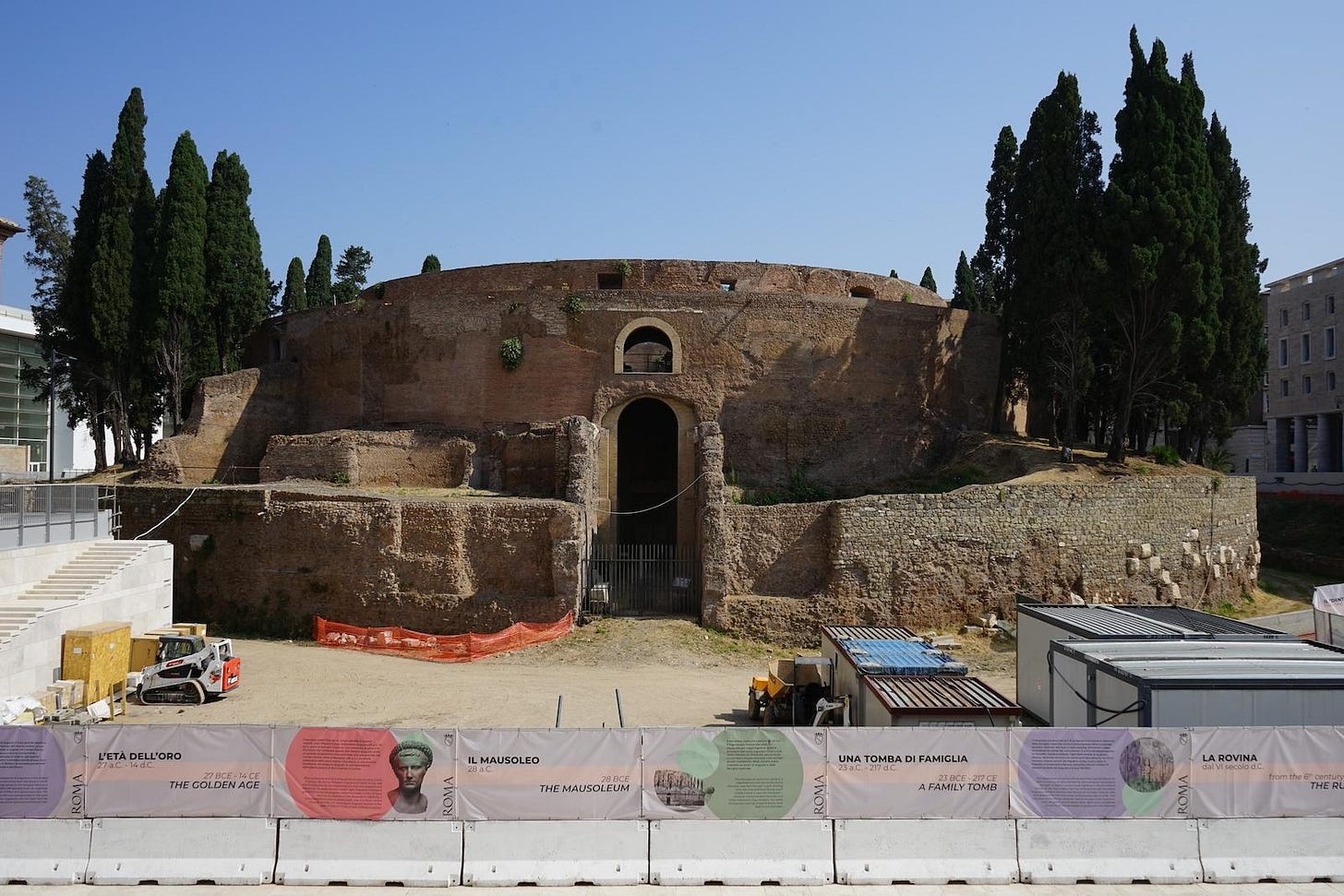In Rome, after nearly two decades in the making, a new piazza in front of the ancient tomb of the Roman Emperor Augustus is finally open.1 (see video)
Bimillenario Augusteo
The reconfiguration of Augustus’ Mausoleum and its surrounding zone and the excavation and reconstruction of the Ara Pacis Roman temple were projects of Mussolini and the entire fascist leadership who were consumed by the myth of imperial romanità and determined to invest heavily in the glorification of Roman heritage to ground their own national and universal aspirations.2
In this wider political and cultural context the fascist authorities took the decision in the early 1930s to celebrate the 2000-year anniversary of Augustus’ birth (23 September 63 bce) in 1937–8.
There were two major projects:
the reconfiguration of Augustus’ Mausoleum and
the excavation and reconstruction of the Ara Pacis Roman temple.
The joint inauguration of the restored Mausoleum and the reconstructed Ara Pacis were the last project that the fascist regime successfully completed in Rome's historic centre.3
Altar of the Augustan Peace
Ara Pacis, also called Ara Pacis Augustae (Latin: “Altar of the Augustan Peace”), is a shrine consisting of a marble altar in a walled enclosure erected in Rome’s Campus Martius (Field of Mars) in honour of the emperor Augustus and dedicated on Jan. 30, 9 bce. The dedication was recorded in Ovid’s Fasti as well as by Augustus himself in his “Res Gestae Divi Augusti” (“Achievements of the Divine Augustus”).4
Rome’s Ara Pacis Augustae (Altar of Augustan Peace) is one of the most famous monuments of the Graeco-Roman world. 5Built between 13 and 9 BCE, it was commissioned by the Roman Senate to honor Emperor Augustus's successful return from campaigns in Hispania and Gaul.6
After Rome's decline, the altar was gradually buried by flooding from the Tiber River. During the Renaissance, scattered pieces were rediscovered, but the full excavation didn't occur until 1937-1938 under Mussolini's regime. The dictator saw the monument as a symbol of Roman glory and had it reconstructed near the Mausoleum of Augustus.
In “‘Framing’ Romanità: The Celebrations for the Bimillenario Augusteo and the Augusteo—Ara Pacis Project,”7 Aristotle Kallis wrote:
In the early 1930s the fascist authorities took the decision to celebrate the 2000-year anniversary of Augustus’ birth, scheduled for 1937–8. The celebrations constituted the pinnacle of fascism’s identification with romanità and underlined Mussolini's growing tendency to identify with an 'imperial' imagery. They also constituted a crucial landmark in the regime's effort to portray Rome as the sacred centre of a new universal political religion. In this article I focus on the two landmark architectural-urbanistic projects in the context of the Bimillenario that were eventually fused into one: the reconfiguration of Augustus’ Mausoleum and its surrounding zone; and the excavation and reconstruction of the Ara Pacis Roman temple. The extravagant programme of architectural-urbanistic interventions in an area of profound archaeological importance inside the historic centre of Rome provides a case-study for assessing the regime’s growing tendency to use architecture and conspicuous, lavish urban planning as acts of 'framing' the past in new 'sacred' locations where space and time interpenetrated. Through projects such as the Augusteo-Ara Pacis the fascist regime aimed to transform the ‘framed’ relics of the Roman palimpsest into 'sacred' access points of a new, decidedly futural and universal temporality.
The new Ara Pacis Museum in Rome opened in the spring of 2006.8
Augustus’ Mausoleum
Completed in 28 BC, 42 years before he actually died, Augustus’ Mausoleum was at that time the largest tomb in the Roman world. In the Middle Ages, the structure was repurposed as a fortress, before then being converted into a garden, and later a bullfighting arena. In the 19th century, a concert hall was built into the brick and concrete shell of the tomb.9
This was ripped out in the 1930s, when Mussolini’s fascist government decided to expose and isolate the ancient monument. The surrounding neighborhood was also demolished and replaced with a quadrangular piazza defined by heavy, rationalist buildings on three sides, and a pavilion to display the Altar of Peace, on the fourth.
The pavilion was replaced in 2006 with a new museum, designed by American architect Richard Meier. That year, a competition was also held to redesign the area immediately around the Mausoleum and was won by a group headed by Italian architect Francesco Cellini. It is this vision which, after a considerable delay, has now been partially realized.
Augustus' Mausoleum Piazza Opens in Rome
Christopher Siwicki. New Piazza Opens Next to Tomb of First Roman Emperor | Art & Object. June 19, 2025.
Kallis, Aristotle. “‘Framing’ Romanità: The Celebrations for the Bimillenario Augusteo and the Augusteo—Ara Pacis Project.” Journal of contemporary history 46.4 (2011): 809–831.
Ibid.
Encyclopædia Britannica Online. 2020.
Strazzulla, Maria José (2009). "War and Peace: Housing the Ara Pacis in the Eternal City". American Journal of Archaeology. 113.
Ara Pacis Museum. See also: Ara Pacis Museum in Rome.
Kallis, Aristotle. “‘Framing’ Romanità: The Celebrations for the Bimillenario Augusteo and the Augusteo—Ara Pacis Project.” Journal of contemporary history 46.4 (2011): 809–831.
Strazzulla, Maria José (2009). "War and Peace: Housing the Ara Pacis in the Eternal City". American Journal of Archaeology. 113.
Christopher Siwicki. New Piazza Opens Next to Tomb of First Roman Emperor | Art & Object. June 19, 2025.






Most enjoyable! Many thanks!
What an interesting collection of re-purposed carnations this tomb underwent!